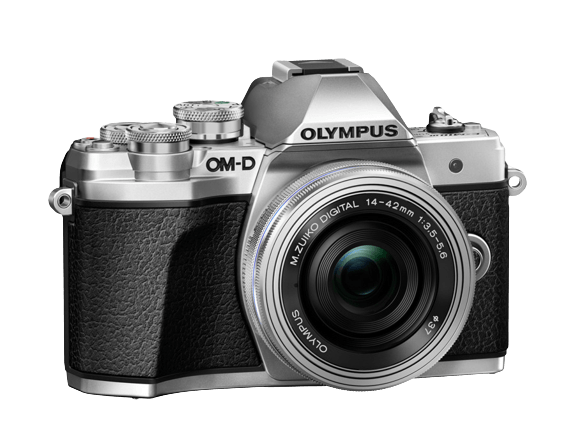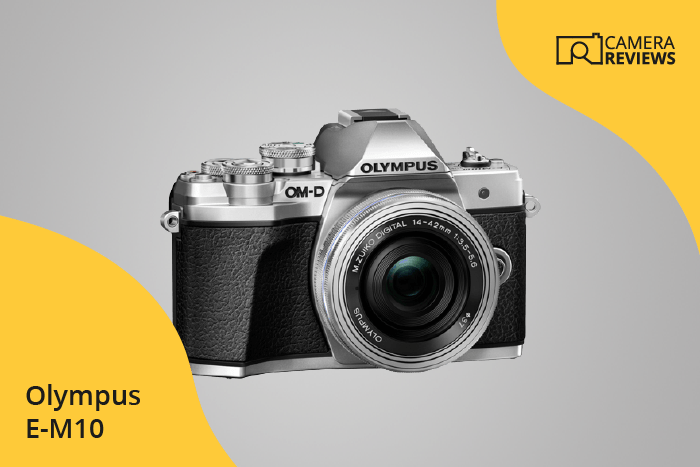Olympus OM-D E-M10 Specs and Scores

The Olympus OM-D E-M10 receives a score of 54/100, which is worth considering when evaluating its general specifications. Launched in 2014, this mirrorless camera originally retailed at $700. Its compact design measures 119 x 82 x 46mm and weighs only 396g (0.87lbs), making it a portable choice for photographers.
While the E-M10 may not be the latest model on the market, it still offers a solid set of features for its price range. This camera provides a good balance between affordability, performance, and portability for photography enthusiasts.
Olympus OM-D E-M10 Overview and Optics
The Olympus OM-D E-M10 receives a score of 57/100 for its optics. This camera features a 16.1-megapixel CMOS sensor, paired with a powerful TruePic VII processor. It has a shooting speed of 8 frames per second, a DXOMARK sensor score of 72, and employs a Micro Four Thirds sensor size. The camera is compatible with a Micro 4/3 lens mount and offers image stabilization.
In the current market, the E-M10’s specifications are modest. The 16.1-megapixel resolution is lower than many modern cameras, and the Micro Four Thirds sensor size is smaller than the more popular APS-C format. However, the camera’s 8 fps shooting speed and image stabilization are noteworthy features that can still benefit photography enthusiasts.
Considering the Olympus OM-D E-M10’s optics, it is a decent camera with some useful features. However, it may not be the top choice for those seeking the highest image quality or the latest technology in the market.
Olympus OM-D E-M10 Video Performance
The Olympus OM-D E-M10 receives a video score of 57/100, which reflects its video capabilities. The camera offers Full HD resolution with maximum dimensions of 1920 x 1080, ensuring decent video quality. However, it only supports a maximum video frame rate of 30fps, which may not be ideal for those seeking smoother footage.
A noteworthy feature of the E-M10 is the built-in time-lapse functionality, allowing users to create captivating time-lapse videos without the need for external software. While the Olympus OM-D E-M10 provides satisfactory video capabilities, it may not be the top choice for videographers in today’s market, as many competitors offer higher resolutions and frame rates. Nonetheless, the E-M10 remains a suitable option for casual video enthusiasts or those primarily focused on photography.
Olympus OM-D E-M10 Features and Benefits
The Olympus OM-D E-M10 receives a feature score of 57 out of 100. This camera comes with a 3-inch touchscreen, which has a resolution of 1,037,000 dots, allowing for clear and sharp image previews. The screen is also a flip screen, providing flexibility in shooting angles. However, the camera lacks GPS and Bluetooth capabilities, although it does include WIFI connectivity for easy sharing and remote control.
In today’s market, the OM-D E-M10’s feature set is somewhat limited compared to newer models. The absence of GPS and Bluetooth can be a drawback for photographers who value geotagging and seamless connectivity. However, the flip screen and touchscreen capabilities are valuable assets for those who prioritize ease of use and versatile shooting options.
The Olympus OM-D E-M10’s features may not be the most advanced, but they still offer a solid foundation for photographers seeking a reliable and user-friendly camera.
Olympus OM-D E-M10 Storage and Battery
The Olympus OM-D E-M10 receives a storage and battery score of 21/100. It features a single memory card slot, which accepts SD, SDHC, and SDXC cards. In comparison to other cameras in today’s market, this is fairly standard, but multiple card slots are becoming increasingly popular for added storage flexibility.
The camera’s battery life allows for 320 shots, which is relatively low compared to many modern cameras. The battery type is BLS-5, and unfortunately, the OM-D E-M10 does not offer USB charging capabilities. This may pose an inconvenience for users who need to recharge frequently or on-the-go.
Considering these factors, the Olympus OM-D E-M10’s storage and battery performance is underwhelming compared to current market standards.
Olympus OM-D E-M10 Alternatives
Do you want to know how the Olympus OM-D E-M10 compares to its competitors? Have a look at the most popular comparisons for this camera below:
- Canon EOS M3 vs Olympus OM-D E-M10
- Fujifilm X-T5 vs Olympus OM-D E-M10
- Canon EOS R7 vs Olympus OM-D E-M10
- Canon EOS RP vs Olympus OM-D E-M10
- Canon EOS 7D vs Olympus OM-D E-M10
- Canon EOS 80D vs Olympus OM-D E-M10
Olympus OM-D E-M10 FAQ
Does the Olympus OM-D E-M10 Have Built-in Image Stabilization?
Yes, the Olympus OM-D E-M10 features a 3-axis in-body image stabilization system, which helps reduce camera shake and produce sharper images, especially in low light situations.
Does the Olympus OM-D E-M10 Support 4K Video Recording?
No, the Olympus OM-D E-M10 does not support 4K video recording. Its maximum video resolution is Full HD 1080p at 60 frames per second.
What Size Sensor Does The Olympus OM-D E-M10 Have?
The Olympus OM-D E-M10 is equipped with a Micro Four Thirds sensor, which is smaller than APS-C sensors but larger than 1-inch sensors, offering a good balance between image quality and compactness.
Does the Olympus OM-D E-M10 Have a Dual Memory Card Slot?
No, the Olympus OM-D E-M10 features a single SD card slot, which supports SD, SDHC, and SDXC memory cards.
Does the Olympus OM-D E-M10 Have a Touch Screen?
Yes, the Olympus OM-D E-M10 has a 3-inch tilting touchscreen LCD, which allows for easy navigation of the camera’s menu and convenient touch-based focus control.
Does the Olympus OM-D E-M10 Have Wi-Fi and Bluetooth?
The Olympus OM-D E-M10 comes with built-in Wi-Fi connectivity, enabling remote control and image transfer via a compatible smartphone. However, it does not have Bluetooth connectivity.
Does the Olympus OM-D E-M10 Have GPS?
No, the Olympus OM-D E-M10 does not have built-in GPS functionality. You can, however, use your smartphone’s GPS data and sync it with your images via the Olympus Image Share app.
Is the Olympus OM-D E-M10 Weather Sealed?
No, the Olympus OM-D E-M10 does not have weather sealing, so it is not recommended to use it in harsh weather conditions without additional protection.
Does the Olympus OM-D E-M10 Have a Built-in Flash?
Yes, the Olympus OM-D E-M10 features a built-in pop-up flash, which can be useful for fill-in lighting or low light situations when an external flash is not available.

